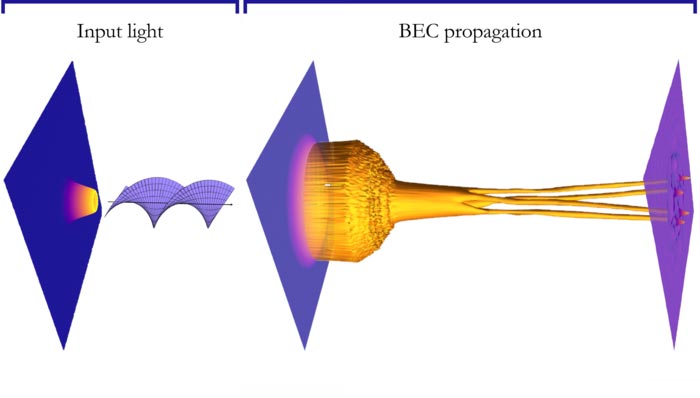A simple way of sculpting matter into complex shapes

In the attached image, light which twists shines on to a moving BEC, breaking it into clusters of BEC droplets that move following the light’s features.
Credit: University of Strathclyde
A new method for shaping matter into complex shapes, with the use of ‘twisted’ light, has been demonstrated in research at the University of Strathclyde.
When atoms are cooled to temperatures close to absolute zero (-273 degrees C), they stop behaving like particles and start to behave like waves.
Atoms in this condition, which are known as Bose–Einstein condensates (BECs), are useful for purposes such as realisation of atom lasers, slow light, quantum simulations for understanding the complex behaviour of materials like superconductors and superfluids, and the precision measurement technique of atom interferometry.
The Strathclyde study has shown that when twisted light is shone on to a moving BEC, it breaks into clusters of BEC droplets that move following the light’s features, with the number of droplets equal to twice the number of light twists. Altering the properties of the light beam can change both the number of BEC droplets and the way that they move.
The research has been published in Physical Review Letters.
Grant Henderson, a PhD student in Strathclyde’s Department of Physics, is lead author on the paper. He said: “By shining a laser beam on to a BEC, we can influence how it behaves. When the laser beam is ‘twisted,’ it has a helical phase profile and carries orbital angular momentum (OAM). Laser beams with OAM can trap and rotate microscopic particles, behaving like an optical spanner.
“This method of shining twisted light through ultracold atoms opens a new and simple way of sculpting matter into unconventional and complex shapes. It has the potential for the design of novel quantum devices such as atomtronic circuits and ultra-sensitive detectors.”
Journal: Physical Review Letters
DOI: 10.1103/PhysRevLett.129.073902
Method of Research: Experimental study
Subject of Research: Not applicable
Article Title: Control of Light-Atom Solitons and Atomic Transport by Optical Vortex Beams Propagating through a Bose-Einstein Condensate
Article Publication Date: 12-Aug-2022
Media Contact
Paul Gallagher
University of Strathclyde
paul.gallagher@strath.ac.uk
Office: 0044-141-548-2370
Cell: 07969 045919
All latest news from the category: Physics and Astronomy
This area deals with the fundamental laws and building blocks of nature and how they interact, the properties and the behavior of matter, and research into space and time and their structures.
innovations-report provides in-depth reports and articles on subjects such as astrophysics, laser technologies, nuclear, quantum, particle and solid-state physics, nanotechnologies, planetary research and findings (Mars, Venus) and developments related to the Hubble Telescope.
Newest articles

First-of-its-kind study uses remote sensing to monitor plastic debris in rivers and lakes
Remote sensing creates a cost-effective solution to monitoring plastic pollution. A first-of-its-kind study from researchers at the University of Minnesota Twin Cities shows how remote sensing can help monitor and…

Laser-based artificial neuron mimics nerve cell functions at lightning speed
With a processing speed a billion times faster than nature, chip-based laser neuron could help advance AI tasks such as pattern recognition and sequence prediction. Researchers have developed a laser-based…

Optimising the processing of plastic waste
Just one look in the yellow bin reveals a colourful jumble of different types of plastic. However, the purer and more uniform plastic waste is, the easier it is to…


